Math Trails – Rickey
| Activity Info | Downtown South Bend | Rickey | Egg Stravaganza | |
|
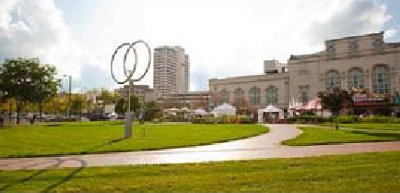
MATH, SCIENCE AND GEORGE RICKEY'S WORK
A Family Walk
A self-guided learning tour connecting math and science with the kinetic sculptures of South Bend native George Rickey
START at the southeast corner of Jefferson and Michigan, and go north. There are five sculptures in this walk:
- SE corner of Michigan and Jefferson (Two Rectangles Horizontal Jointed Gyratory)
- NW corner of Michigan and Jefferson (Two Planes Vertical Horizontal IV)
- SW corner of Michigan and Colfax (Four L's Excentric II)
- Jon R. Hunt Plaza, outside the Morris (Annular Eclipse V) Then head south to:
- SW corner of Michigan and Washington (Breaking Column) Then take Washington east to:
- South Bend Museum of Art's rotunda entrance (Chevron Theme)
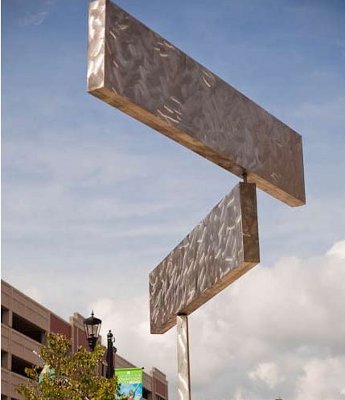
George Rickey, Two Rectangles Horizontal Jointed Gyratory, 1994,
stainless steel. Southeast corner of Michigan and Jefferson.
- Watch the two rectangles for several minutes. How likely is it for one of the rectangles to point at a right angle from the other rectangle? How likely is it for one of the rectangles to form a straight line with the other rectangle? How likely is it for one of the rectangles to point straight down at the ground?
- What are some of the questions you have about the sculpture? Which of them do you think a scientist could answer?
- John is sure that electricity makes the sculpture move, but Alyssa thinks that it's powered by wind. How can they decide who's right?
- What would be some positive aspects of using an electric motor to power the sculpture instead of the wind? What would be some negatives?
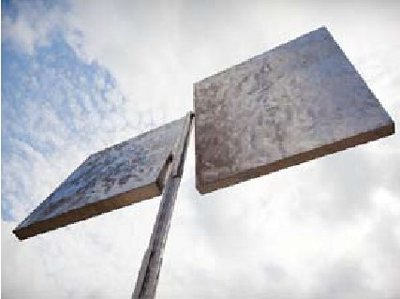
George Rickey, Two Planes Vertical Horizontal IV, 1974, stainless
steel. Northwest corner of Michigan and Jefferson.
- Suppose that the dimensions of the rectangular solid forming one of the planes are 79" x 70" x 2". What is the surface area of the solid? Volume?
- Look at the location of the pivot point for each plane in the sculpture. For each plane, estimate the ratio of the amount of the plane above the pivot point to the amount of the plane below the pivot point.
- Do you think people could have made this sculpture 1,000 years ago? Why or why not? What aspects do you think would have been the hardest? The easiest?
- What kinds of things did Rickey need to know about balances and weights to make this sculpture? What other science concepts would he have needed to be aware of?
- Time yourself to see how long it takes to walk from Two Rectangles Horizontal Jointed Gyratory to Two Planes Vertical Horizontal IV. How long should it take to walk from Two Planes Vertical Horizontal IV to Breaking Column? When many people think of speed, they think of miles per hour. What might be a better way to measure your speed now? Express your speed in blocks per hour.

George Rickey, Four L's Excentric II, 1978-1990, stainless
steel. Southwest corner of Michigan and Colfax.
- Are any of the four L's congruent to each other?
- Are any of the four L's similar to each other?
- Sketch the four L's in the configuration where they are confined to a single plane. What motions would you need to perform to move on of the four L's onto its congruent partner?
- How does gravity affect this sculpture when it is still? When it is moving?
- This sculpture can be used to illustrate all four dimensions. Find a part of this sculpture that is zero dimensional. Find other aspects that are one dimensional, two dimensional, and three dimensional. In what sense is this sculpture four dimensional? (Hint: Think about time as the fourth dimension.)
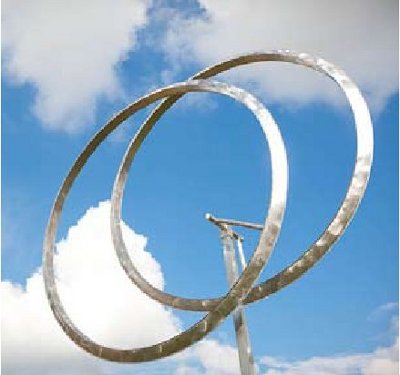
George Rickey, Annular Eclipse V, 2000, stainless steel.
Jon R. Hunt Plaza, Morris Performing Arts Center
- Estimate the diameter of one of the circles.
- Using your estimated diameter, compute the circumference of the circle.
- If the diameter of each circle is represented by d, and the length of the line between the point of rotation and the edge of the circle is s, write an expression for the widest span that the sculpture can achieve from left to right. Write an expression for the narrowest span the sculpture achieves.
- What problems might Rickey have had getting the sculpture to move in the wind?
- Over short distances, wind travels in a straight line. How is it pushing the sculpture in a circle? What piece of the sculpture is responsible for this?
- How are each of the following a part of
the sculpture?
- sunlight
- heat energy
- wind energy
- energy of motion
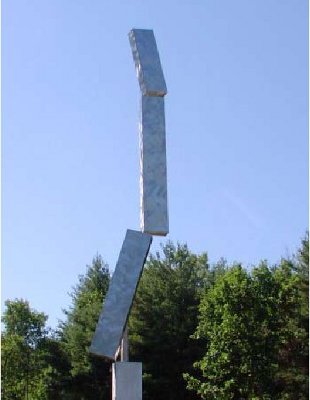
George Rickey, Breaking Column, 1989, stainless steel
Southeast corner of Michigan and Washington.
- Measure the width of the base of this sculpture in inches. Measure the same length in centimeters. Do you need more inches or centimeters to equal the width? Which units allow you to measure more accurately? If you measured to the nearest sixteenth of an inch, would your measurement be more or less accurate compared to measuring to the nearest millimeter?
- Use an indirect measuring technique to estimate the height of the column when it is vertically aligned.
- How far can the tip of the top piece move? How far could it move if the bot- tom piece were bolted into place?
- If the wind blew only on the second piece from the top, would the rest of the sculpture still move? How? What if only the third piece got wind?

George Rickey, Chevron Theme, 1990, stainless steel.
Outside of front rotunda, South Bend Museum of Art.
- Suppose x represents one length of the shorter bars, and y represents the length of the longer bars. How wide and tall is the W in terms of x and y?
- What shape is each bar in this piece?
- Can you see any right angles in the sculpture? Can you see any acute angles And obtuse angles?
- Do you see any complimentary or supplementary angles in this sculpture? How do you know?
- What is the sum of the interior angles of one of the W shapes?
- If the wind suddenly stopped moving, would the sculpture suddenly stop, too? How long would it take to stop moving? In what directions would it move until it settled down? Once it reaches equilibrium and stops moving, what would get it moving again?
George Rickey
Kinetic Sculpture
South Bend 2009–10
A year-long collaborative celebration of internationally renowned artist and South Bend native George Rickey.
- Public Art: Five of Rickey's large, mesmerizing kinetic sculptures line downtown South Bend's Michigan Street throug,/h Sept. 2010
- Major Exhibition: South Bend Museum of Art hosts Arc of Development, a major Rickey exhibition featuring some 100 paintings, drawings, and garden-scale sculptures through Jan. 10, 2010
- Archives: Notre Dame's Snite Museum of Art, home of the George Rickey Sculpture Archive, has 20 Rickey sculptures on exhibit, hosted a George Rickey symposium and published a catalog of the Archive in Sept. 2009
- Educational Outreach: University physics and mathematics faculty are collaborating with area teachers to develop tools that use Rickey's work to explore the connections between art, science, math, and life
For related science activities and additional information, see NISMEC's webpage at http://rickeysculptures.net/
Innovation: George Rickey Kinetic Sculpture is a collaboration among the Community Foundation of St. Joseph County, the South Bend Museum of Art, Notre Dame's Snite Museum of Art, the Estate of George Rickey, the George Rickey Foundation, and 1st Source Bank, with assistance from the City of South Bend.
All art by George Rickey is a copyright of the Estate of George Rickey/George Rickey Foundation. Licensed by VAGA, New York, NY.


